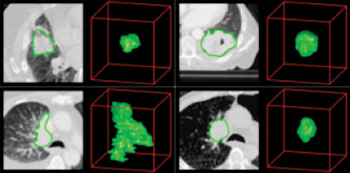Radiomics Imaging Analysis Used to Visualize a Tumor’s Fingerprint to Predict Progression and Enhance Treatment
By MedImaging International staff writers
Posted on 10 Jun 2014
Scientists have developed a new cost-effective medical imaging analysis method to predict the risk of dying of cancer in patients. For the first time, they have been able to make a visual fingerprint of a tumor that provides detailed information. The new technology can be used to predict the cancer’s progress and to optimize treatment options.Posted on 10 Jun 2014
The new technique is known as radiomics and it utilizes standard imaging technology present in every hospital. Based on the specific information acquired with radiomics, clinicians can choose and apply the most effective treatment for each patient. The technology extracts and analyzes large amounts of quantitative imaging data with high throughput from medical images obtained with computed tomography (CT), positron emission tomography (PET), or magnetic resonance imaging (MRI). Importantly, these data are devised to be collected from standard-of-care images, leading to a very large potential subject pool. Radiomics data can be used to construct descriptive and predictive models relating image features to phenotypes or gene-protein signatures.

Image: Extracting radiomics data from CT scans of lung cancer patients. CT images with tumor contours left, three-dimensional visualizations on the right (Photo courtesy of the Maastricht University Medical Center).
The researchers have published their findings June 3, 2014, in the journal Nature Communications. Tumors can differ considerably in terms of their properties, for instance, their shape, size, and/or composition. Medical imaging technologies, such as a CT scan, offer a straightforward way of making some of these characteristics visible. In itself, however, the image reveals nothing about how the tumor will develop. Now, researchers have demonstrated that the new radiomics technique can predict a tumor’s progress. The researchers are participating in a major international study headed jointly by investigators from Maastricht University Medical Center (Maastricht UMC; Maastricht, The Netherlands) and Harvard Medical School (Boston, MA, USA).
The researchers quantified 440 features taken from a total of 1,019 CT scans of lung cancer and head and neck cancer patients. This involved using advanced and intelligent software that converts the tumor characteristics seen in a scan into clinically meaningful numbers, giving rise to a kind of outline for that specific tumor.
“That data allows us to unravel the digital fingerprint of each separate tumor, in a manner of speaking,” said Dr. Philippe Lambin, professor of radiotherapy at Maastricht UMC and project leader. “We discovered that a subset of the lung tumors shared four characteristics related to intratumor heterogeneity and these cancers grew and proliferated faster than others, leading to worse patient outcomes. What really surprised us is that the exact same four characteristics—the same signature, if you like—showed up in aggressive, head and neck cancers too, again predicting a poorer survival after radiation therapy. That’s exceptionally valuable information that we can use to predict the progress of the cancer, among other things. We can now identify patients who will benefit from stronger medication, for example, while keeping treatment simple, pain-free, and cost-effective.”
The researchers are currently engaged in software development that will make the technique readily available to clinics worldwide at low cost. “The software doesn’t require any additional knowledge of medical imaging techniques, so it’s an ideal complement to existing hospital technology,” said clinical physicist André Dekker of the MAASTRO Clinic. The pharmaceutical industry has already taken a strong interest in radiomics.
Dr. Hugo Aerts of Maastricht UMC, who is currently conducting research at Harvard University, noted, “When we can get detailed information about a tumor before commencing treatment, we can tailor that treatment to the individual patients. This personalized medicine approach can result in much more effective treatment. That’s why radiomics could have a major influence on the development of personalized medicine in the field of proton therapy as well as the pharmaceutical industry.”
Related Links:
Maastricht University Medical Center
Harvard Medical School














